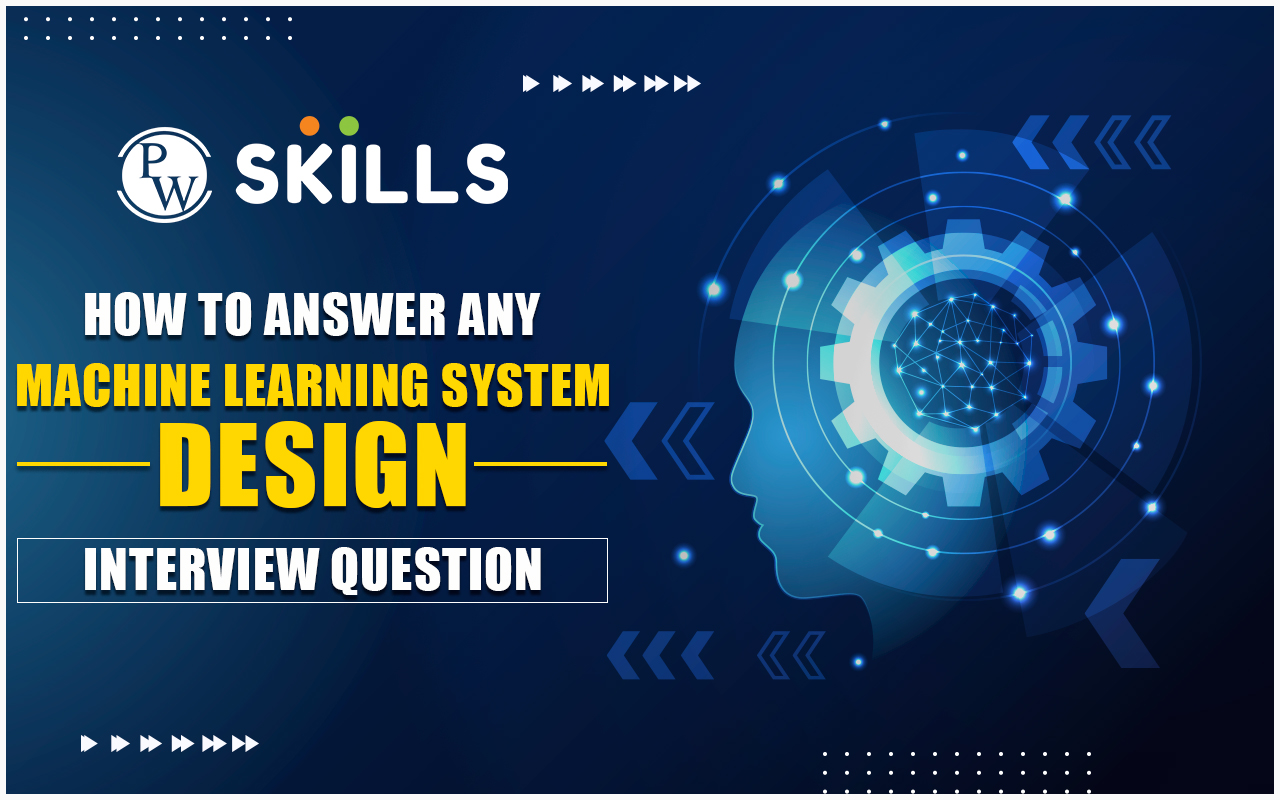Machine Learning System Design: Machine learning system design interviews have become a crucial aspect of the hiring process in the field of data science and artificial intelligence. These interviews assess a candidate’s ability to not only understand the theoretical underpinnings of machine learning but also apply that knowledge to real-world scenarios.
In this blog, we’ll talk about the key components of machine learning system design interviews and how you can answer any interview question effortlessly.
If you’re looking to start a career in system-design, then the PhysicsWallah 10-Day System Design Workshop could be just what you need! This workshop will equip you with the knowledge and skills required to succeed as a system designer. So, enrol now!
Understanding the Basics

Exploring system design requires revisiting machine learning basics: supervised learning, unsupervised learning, and reinforcement learning. These are the pillars of ML systems, and understanding their strengths and weaknesses is crucial for effective application.
Additionally, a solid grasp of key algorithms and models, such as regression, classification, and clustering, is crucial. Evaluation metrics, like precision, recall, and F1 score, are the yardsticks by which model performance is measured. By having a strong foundation in these basics, you set the stage for effective problem-solving during interviews.
How to Answer Any Machine Learning System Design Interview Question?
Mastering machine learning system design interview questions demands a systematic and strategic approach, showcasing a profound grasp of core principles and an ability to construct solutions for intricate challenges. To excel in such assessments, candidates must artfully illustrate their capacity to design machine learning systems that are scalable, efficient, and resilient. Here’s a guide on navigating these questions with finesse:
- Understand the Problem: Begin by comprehensively grasping the problem statement. Break it down into key components, elucidating primary goals and constraints. This establishes the foundation for a structured and organised response.
- Outline High-Level Architecture: Clearly articulate the high-level architecture of the system. Commence with data collection and preprocessing, progressing to model selection and training. Justify your choices, considering factors like data volume, computational resources, and model complexity.
- Address Scalability: Early in your response, tackle scalability concerns. Deliberate on how the system copes with substantial datasets and growing user demands. Discuss potential bottlenecks and propose solutions to ensure scalability.
- Effective Communication: Convey your thought process, assumptions, and trade-offs clearly. A well-articulated response not only showcases technical expertise but also underscores effective communication skills—crucial in any collaborative work setting.
- Emphasise Trade-offs: Highlight your comprehension of the trade-offs inherent in designing machine learning systems. Discuss the delicate balance between model complexity and interpretability, as well as the trade-off between accuracy and computational efficiency.
- Deployment and Monitoring: Consider the deployment and monitoring aspects of the system. Outline how models would be deployed in a production environment, ensure real-time predictions, and implement monitoring mechanisms for prompt issue identification and resolution.
- Adaptability: Be prepared to adapt your solution to evolving requirements. Discuss how your design accommodates changes in dataset distribution, model updates, and shifting business objectives.
Machine Learning System Design Interview Tips and Best Practices
Here are some of the best tips for machine learning system design interviews:
Time Management During Interviews
Time management is a critical aspect of excelling in machine learning system design interviews. Most interviews have a fixed duration, and effectively utilising every minute can make the difference between a well-structured solution and a rushed attempt.
- Prioritise Tasks: Begin by understanding the components of the problem and prioritise tasks based on their complexity and importance. Tackling the most critical aspects first ensures that even if time runs short, you’ve addressed the core requirements.
- Set Milestones: Break down the problem into smaller milestones. Regularly assessing your progress against this foundation serves as both a guide for your solution and a means to adapt your strategy if you fall behind.
- Practice Time-Boxing: During your preparation, practice solving problems within a time limit. This helps develop a sense of how much time different components of a problem might take. Time-boxing also instils discipline, preventing you from getting stuck on one aspect for too long.
- Stay Calm and Focused: In challenging situations or time constraints, it’s important to remain composed and focused. Panicking hampers decision-making and wastes valuable time. Maintaining a calm demeanour not only exhibits communication skills but also reflects a comprehensive problem-solving approach.
Handling Unexpected Challenges and Uncertainties
Machine learning interviews are designed to assess not just your technical skills but also your ability to handle ambiguity and unexpected challenges. Here are some strategies for gracefully navigating uncertain situations:
- Clarify Ambiguous Points: If the problem statement is unclear or if you’re unsure about certain requirements, don’t hesitate to seek clarification from the interviewer. This not only demonstrates your communication skills but also shows that you approach problems with a thorough understanding.
- Break Down the Problem: When tackling intricate problems, it’s beneficial to dissect them into smaller, more manageable parts. This systematic approach not only makes the problem more digestible but also showcases your problem-solving thought process.
- Communicate Your Thought Process: Articulate your thinking clearly as you work through the problem. Interviewers are often interested in understanding how you approach challenges and whether you can communicate your ideas effectively. Even if you’re unsure about a particular aspect, explaining your thought process can earn you valuable points.
- Adaptability is Key: Machine learning is a rapidly evolving field, and interviewers may deliberately introduce new or unexpected elements to test your adaptability. Embrace these challenges with a positive attitude, showcasing your ability to think on your feet and adapt your strategies as needed.
Continuous Learning and Staying Updated
The machine learning scene changes fast, with fresh algorithms, frameworks, and top practices popping up regularly. Displaying a dedication to ongoing learning isn’t just advantageous for interviews but also crucial for your prolonged success in the field.
- Dive into Research Papers: Keep updated on the newest developments by consistently delving into research papers. Get to know cutting-edge algorithms and techniques. In interviews, citing recent progress can make you stand out.
- Connect with the Community: Be part of online forums, attend meetups, and engage in discussions about machine learning. Involvement in the community exposes you to diverse viewpoints and gives insights into real-world applications and hurdles.
- Create and Experiment: Use what you learn by tackling personal projects or contributing to open-source ventures. Putting theoretical knowledge into practice not only reinforces your understanding but also reveals your enthusiasm for the field.
- Remain Inquisitive: Develop a curious mindset. Pose questions, aim to comprehend the “why” behind concepts, and don’t hesitate to explore subjects beyond your comfort zone. A genuine curiosity for learning is a trait highly prized in the dynamic realm of machine learning.
Conclusion
In conclusion, mastering machine learning system design interviews requires a combination of solid theoretical knowledge and practical problem-solving skills. Mastering interviews requires grasping fundamentals, dissecting problems methodically, and gleaning insights from triumphs and setbacks. Confidence blooms when armed with this understanding.
Thriving in the dynamic realm of machine learning hinges on perceptual learning and a steadfast dedication to staying current. As you delve into the realm of mastering machine learning system design interviews, keep in mind that each interview serves as a chance to display your distinct skills and viewpoint. Tackle each query with eagerness and a hunger for knowledge. This approach propels you toward triumph in the fiercely competitive landscape of machine learning.
Machine Learning System Design FAQs
How can I effectively demonstrate adaptability in my machine learning system design interview response?
Discuss how your proposed solution accommodates changes in dataset distribution, model updates, and evolving business objectives. Showcase your flexibility in anticipating and addressing dynamic requirements.
What's the significance of addressing scalability concerns early in the machine learning system design interview?
Addressing scalability early showcases foresight and planning. Discuss how the system copes with large datasets and increasing user demands, highlighting potential bottlenecks and proposing solutions for seamless scalability.
How do I strike a balance between model complexity and interpretability in my response?
Articulate the trade-offs involved in your design, emphasising the delicate balance between model complexity and interpretability. Justify your choices based on the specific needs of the problem and the context of the application.
Why is effective communication crucial in machine learning system design interviews?
Effective communication is essential as it not only demonstrates technical prowess but also ensures that your thought process, assumptions, and trade-offs are conveyed clearly. Clear communication is vital in collaborative work environments.
Can you provide insights into the deployment and monitoring aspects of a machine learning system?
Discuss how models would be deployed in a production environment, ensuring real-time predictions. Additionally, elaborate on the monitoring mechanisms you would implement to identify and address issues promptly in a deployed system.




